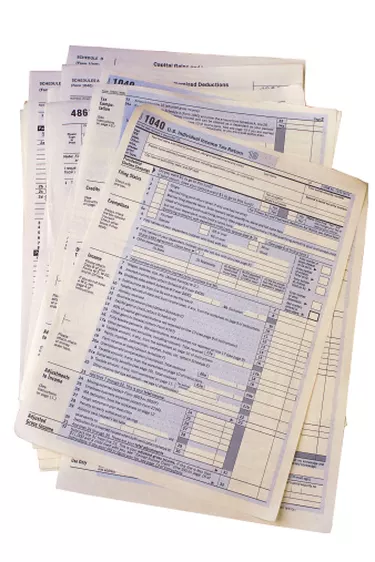
If you made any type of voluntary payment arrangements with the Internal Revenue Service, such as offers in compromise, installment agreements and uncollectable status, you must file a form 433A, Collection Information Statement for Individuals. This form allows the IRS to collect unpaid taxes on wages earned or for people who are self-employed but did not report certain earnings on normal tax returns. Although the IRS does not need a form 433A to collect on the unpaid taxes, your cooperation in filing the form allows the IRS to receive the necessary information for collection activities so that you will not receive a levy on your assets.
Wage Earners
Video of the Day
Step 1
Fill out form 433A - Collection Information Statement for Wage Earners and Self-Employed Individuals. Complete the first four sections of the form if you are a wage earner. Complete the first four sections along with section five and six if you are a self-employed person. Provide an answer for every space. If a question does not apply to you, write down "N/A" for non-applicable. This form is the 2008 IRS form edition at the date of this publication and may be likely to change. Always contact the IRS for any form changes.
Video of the Day
Step 2
Start filling out the form by writing in your personal information as the taxpayer along with your spouse's information in section one: Personal Information. Include full names, addresses, phone numbers and marital status on the spaces provided. Complete the first section by providing the name, age and relationship of dependents as well as providing information about your and your spouse's Social Security numbers, dates of birth, driver's license numbers and the state where you live.
Step 3
Place the required information for employment in section two: Employment Information. Pen in your and your spouse's employer addresses, names, work phone numbers, occupations, how long you each have been employed at your business and the length of pay period you have. Provide information on whether the IRS may contact you at work and whether you had claimed any number of exemptions on a W-4 form.
Step 4
Complete section three to report other financial information. Provide information consisting of whether the individual or sole proprietorship has any active lawsuit procedure, ever filed for bankruptcy, or if there is any anticipated increase/decrease in business or personal income. Also include information regarding whether you are a beneficiary of a trust, estate or life insurance policy or if you have ever lived outside the United States for six months or more within the past 10 years.
Step 5
Write in all personal asset information for all individuals in section four on page two of the 433A form. Types of personal assets consist of cash on hand, personal bank accounts, investments, available credit, life insurance policies and transfers of assets for less than their full value to other people within the past 10 years. Other personal assets you need to include are personal vehicles leased or purchased. Complete section four by marking down all monthly income and expenses. Sign and date the form and have your spouse do the same.
Self-Employed
Step 1
Fill out the first four sections of the 433A form along with section five and six if you are self-employed. Complete section five by providing information regarding your personal business. Indicate whether the business is a sole proprietorship. Include your business name, employer identification number, type of business along with whether you are a federal contractor and the business website address.
Step 2
Provide the total number of employees on the space provided. Write down the average gross monthly payroll and the frequency of tax deposits. Indicate if your business engages in e-Commerce and list the payment processors. Place the types of credit cards accepted by your business in section five along with how much business cash you have on hand, total cash in banks, your accounts and notes receivable and your total outstanding balance.
Step 3
Complete section five by writing down all business assets with property description and locations. Provide your total business equity before moving on to section six of the 433A form regarding your sole proprietorship information. Check the appropriate box on whether you use a cash or accrual accounting method. Indicate the timeframe of income and expenses corresponding to when you are reporting this IRS filing. Calculate the total monthly business income and total monthly expenses to finish the 433A form.
Filing 433A form
Step 1
Make sure to sign and date section four before sending your form to the IRS. The 433A form will often accompany form 656: Offer to compromise. Send the 433A form to the Memphis Internal Revenue Service, Center COIC Unit at PO Box 30803 AMC if you live in the western United States, including Hawaii, and are a wage earner, self-employed or a retiree.
Step 2
Mail the 433A form to the Memphis Internal Revenue Service, Center COIC Unit at PO Box 30804 AMC if you live in the western United States and you are not a wage earner, self-employed or a retiree. Send form 433A to Brookhaven Internal Revenue Service Center COIC Unit PO Box 9007 if you reside in the eastern part of the United States, Puerto Rico or at a foreign address and you are a wage earner, self-employed or a retiree.
Step 3
Send form 433A to Brookhaven Internal Revenue Service Center COIC Unit PO Box 9008 if you are other than a wage earner, self-employed or a retiree while residing in the eastern part of the United States, Puerto Rico or at a foreign address. Check with the IRS about your particular status and residence before filing.